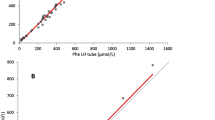Abstract
Objectives
The objectives of this study were to determine the value of phenylalanine (Phe) loading for diagnosing dopa-responsive dystonia (DRD) in children.
Methods
We investigated orally administered Phe loading tests (100 mg/kg) in seven patients with confirmed DRD and 17 pediatric patients with clinically suspected but excluded DRD. Results of Phe, tyrosine (Tyr), and biopterin from plasma and dried blood spot (DBS) analyses were correlated, and pediatric cutoff values established.
Results
The peak Phe concentration following a Phe load in the pediatric DRD population is lower than reported in adults. By using adult cutoff values and either Phe/Try ratios or biopterin concentrations only, false positive and false negative results are frequent. Only the combined analysis of the Phe/Tyr ratio and biopterin concentration is reliable in children. In children with DRD, dried blood Phe/Tyr ratio exceeded 4.6 (plasma Phe/Tyr ratio >5.4) after 2 h and biopterin concentration in dried blood remained below 16.2 nmol/L (plasma biopterin <14 nmol/L) 1 h after Phe challenge.
Conclusions
Phe loading is a useful tool for diagnosing DRD in children. Test duration can be reduced to only 2 h, and specific pediatric cutoff values need to be applied. Simultaneous measurements of the Phe/Tyr ratio and biopterin in plasma or DBS are essential in pediatric patients.




Similar content being viewed by others
References
Segawa M, Nomura Y, Nishiyama N (2003) Autosomal dominant guanosine triphosphate cyclohydrolase I deficiency (Segawa disease). Ann Neurol 54(Suppl 6):S32–S45
Thöny B, Auerbach G, Blau N (2000) Tetrahydrobiopterin biosynthesis, regeneration and functions. Biochem J 347(Pt 1):1–16
Nygaard TG (1993) Dopa-responsive dystonia. Delineation of the clinical syndrome and clues to pathogenesis. Adv Neurol 60:577–585
Grimes DA, Barclay CL, Duff J, Furukawa Y, Lang AE (2002) Phenocopies in a large GCH1 mutation positive family with dopa responsive dystonia: confusing the picture? J Neurol Neurosurg Psychiatry 72:801–804
Bandmann O, Valente EM, Holmans P et al (1998) Dopa-responsive dystonia: a clinical and molecular genetic study. Ann Neurol 44:649–656
Blau N, Bonafe L, Thöny B (2001) Tetrahydrobiopterin deficiencies without hyperphenylalaninemia: diagnosis and genetics of dopa-responsive dystonia and sepiapterin reductase deficiency. Mol Genet Metab 74:172–185
Hyland K, Fryburg JS, Wilson WG et al (1997) Oral phenylalanine loading in dopa-responsive dystonia: a possible diagnostic test. Neurology 48:1290–1297
Bandmann O, Goertz M, Zschocke J et al (2003) The phenylalanine loading test in the differential diagnosis of dystonia. Neurology 60:700–702
Saunders-Pullmann R, Blau N, Hyland K et al (2004) Phenyalanine loading as a diagnostic test for DRD: interpreting the utility of the test. Mol Genet Metab 83:207–212
Lopez-Laso E, Ormazabal A, Camino R et al (2006) Oral phenylalanine loading test for the diagnosis of dominant guanosine triphosphate cyclohydrolase 1 deficiency. Clin Biochem 39:893–897
Schulze A, Lindner M, Kohlmuller D, Olgemoller K, Mayatepek E, Hoffmann GF (2003) Expanded newborn screening for inborn errors of metabolism by electrospray ionization-tandem mass spectrometry: results, outcome, and implications. Pediatrics 111:1399–1406
Blau N, Thöny B (2008) Pterins and related enzymes. In: Blau N, Duran M, Gibson KM (eds) Laboratory guide to the methods in biochemical genetics. Springer-Verlag, Heidelberg, Berlin, pp 665–702
Zurflüh MR, Giovannini M, Fiori L et al (2005) Screening for tetrahydrobiopterin deficiencies using dried blood spots on filter paper. Mol Genet Metab 86(Suppl 1):S96–S103
Blau N, Duran M, Blaskovics Me (2003) In: Physician's Guide to Laboratory Diagnosis of Metabolic Diseases, Chapter 2, 2nd edn. Springer, London, Berlin, pp. 89-106
Bonafe L, Thony B, Leimbacher W, Kierat L, Blau N (2001) Diagnosis of dopa-responsive dystonia and other tetrahydrobiopterin disorders by the study of biopterin metabolism in fibroblasts. Clin Chem 47:477–485
Acknowledgements
We thank Mrs. Brigitte Schmidt-Mader, Mr. Alexandros Anninos, and Mrs. Bettina Abu Seda for skilful technical assistance. This study was supported in part by the Swiss National Science Foundation grant no. 3100A0-119982/1 (to NB).
Author information
Authors and Affiliations
Corresponding author
Additional information
Communicated by: Jean-Marie Saudubray
Competing interest: None declared.
An erratum to this article can be found at http://dx.doi.org/10.1007/s10545-010-9205-4
Rights and permissions
About this article
Cite this article
Opladen, T., Okun, J.G., Burgard, P. et al. Phenylalanine loading in pediatric patients with dopa-responsive dystonia: revised test protocol and pediatric cutoff values. J Inherit Metab Dis 33, 697–703 (2010). https://doi.org/10.1007/s10545-010-9164-9
Received:
Revised:
Accepted:
Published:
Issue Date:
DOI: https://doi.org/10.1007/s10545-010-9164-9




